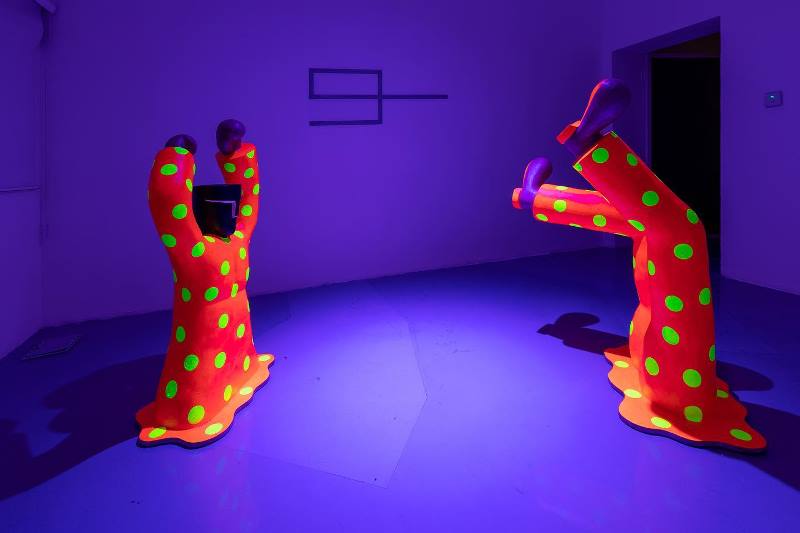Is a puppet different from a sculpture? Perhaps this question is among the first that comes to mind when attending Roozbeh Nemati Sharif’s exhibition titled ‘Siah Bazi’ at Soo Gallery; an exhibition where Nemati Sharif presents 34 of his works with a look at the ancient tradition of black-face theater in Iran.
Roozbeh Nemati Sharif says, “My artworks do not represent a theatrical space, yet this assumption might occur to the viewer that I have depicted a theatrical character in my works. The black-face jester symbolizes the ‘common people’ in society, a character both honest and humerous, conveying criticism of authority through humor, jest, or mockery, as if acting as a mediator between power and the people. I have utilized this characteristic of black.”
The theatrical tradition of black play is rooted in ancient Iranian performance customs associated with Nowruz rituals. It is said that this form of performance likely originated during the Safavi period, but it reached its peak during the Qajar era and thereafter gradually marginalized with the emergence of modern forms of theater in Iran or continued in new forms.
It is this amalgamation and the artist’s use of black play performances that have made his exhibition distinct from other sculpture exhibitions in Iran. Regarding this, he says, “In this exhibition, we deal with less fluid volume compared to my previous exhibitions and encounter more tranquility. The forms are industrial and soulless. Within these forms, I found a space that resonates with our traditional architectural and spacial design, and by adding an icon derived from theater and performance traditions, I have intertwined tradition and modernism in a unique way. This capture, in my view, is innovative.”
Javid Ramazani, art critic and conservator of artworks, discusses the relationship between dolls and sculptures in the works of Roozbeh Nemati Sharif: “His works carry a sense and sentiment of theatrical tradition, showcasing the continuity of the doll-making workshop tradition inherited from his father. He has transformed these dolls and brought them towards a newer environment. This artist works more cohesively on the space of tradition and the past by revisiting the past. In my opinion, the artist’s use and fusion of various mediums renew his work and lend a fresh coherence to his artworks.”
In the artist’s new works, the boundary between painting, bas relief, and broken sculpture is blurred, and the artist plays with these forms and our understanding of them. Nemati Sharif explains, “These works occupy a space between painting, bas relief, and volume. In my exhibition, I have utilized all these mediums and their capabilities to create an indeterminate space, aiming to work in the void space between them.”
However, beyond technique and execution, this sculptor also emphasizes the subject matter of his works, considering their basis and background ‘social,’ viewing violence as part of the societal situation. He says, “The background of my artwork is social, and violence is a societal condition. My previous exhibition was explicitly about violence; however, the works in this exhibition do not directly address this theme. Themes such as struggle, defeat, and fighting, when a war is underway. Violence is also part of this war, and continuous warfare persists, with no clear winner or loser; whoever wins can be just as defeated.”
Ramazani emphasizes the theme of violence in Nemati Sharif’s works and explains in this regard, “The previous exhibition of this artist was based on violence, and this time he emphasizes a form of violence that is covertly occurring in the world; however, in his previous exhibition, there was a void of indigenous discourse and childhood experience. Now, Nematii Sharif has revitalized the space by using a theatrical character and adding childhood experiences.
I think this coherence is very important. The space that the artist has seen and depicted in these works allows him to present catharsis with a form of social discharge.
The theme of the works contrasts sharply with cheerful colors, displaying seductive visual aspects; however, they can be full of fear, horror, and turmoil, displaying the burden of existence’s anxiety in these works. With this view, not only can the audience view these works as beautiful, but the artist also shows them that they can return to childhood.”
The artist’s collaboration with Soo Gallery and the audience’s encounter with the exhibition are important topics related to the artist. In this regard, he says, “I need a large space to display my works, which Soo Gallery provides for me. At the same time, I do not accept advice easily, and Soo Gallery provides me with the possibility of freedom. The space of these works is new for the audience, and it has not yet settled well in our art space. Even the target audience may be surprised; the audience may not yet have enough capacity to confront this form of sculpture adequately.”


